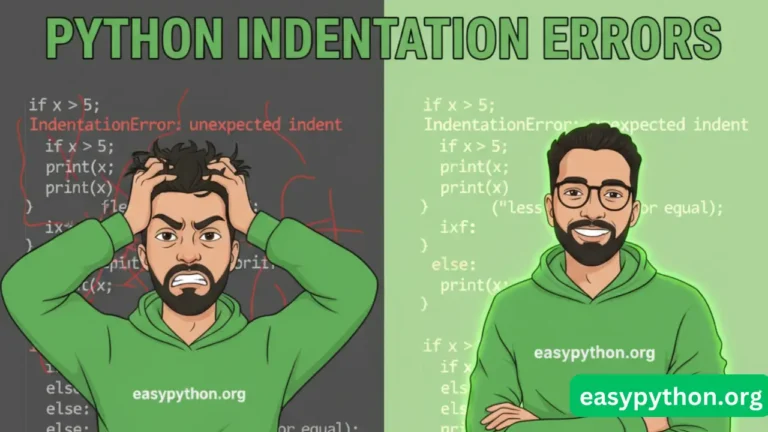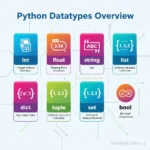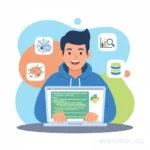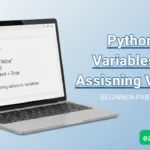Let’s be honest — nothing kills your vibe faster than running a shiny new Python script only to be slapped with:
IndentationError: unexpected indentLike bruh… really? You just wanted to print “Hello, World!” and suddenly Python is acting like a strict English teacher deducting marks because your margin was off by 0.5 cm.
If you’re here, chances are you’ve been betrayed by a single space or that evil thing called a tab. Don’t worry — you’re not alone. In fact, Python beginners everywhere are out there sobbing into their keyboards.
But today, my friend, we’re going to roast indentation errors until they cry, explain them like you’re five, and show you how to fix them like a pro. Buckle up.
Why Python Even Cares About Indentation
Most programming languages don’t give a flying semicolon about spaces. C, Java, JavaScript? They’ll let you indent like a drunk poet and still run.
But Python? Nope. Python is that neat freak roommate who freaks out if you leave one dirty spoon in the sink.
Instead of curly braces {} like in C or Java, Python uses indentation to define code blocks. That means:
if True:
print("Indented correctly") # ✅ works
print("Oops, outside") # ✅ works tooBut the moment you mess up indentation:
if True:
print("Broken!") # ❌Python throws a tantrum:
IndentationError: expected an indented blockBasically: indentation = Python’s love language. Ignore it, and you’re in the doghouse. 🐶
Common Types of Python Indentation Errors
1. Unexpected Indent
When you randomly indent code for no reason:
print("Hello")
print("World") # ❌Error:
IndentationError: unexpected indentFix: Stop indenting like you’re trying to make ASCII art.
2. Expected an Indented Block
When Python wants indentation but you ghost it:
if True:
print("Hello") # ❌Error:
IndentationError: expected an indented blockFix: Indent after colons : — they’re basically Python’s “time to indent” emojis.
3. Unindent Does Not Match Any Outer Indentation Level
This one is pure evil. You think your code looks fine, but Python’s like:
IndentationError: unindent does not match any outer indentation levelTranslation: you mixed spaces and tabs. 😡
def greet():
print("Hello") # 4 spaces
print("World") # tab ❌Fix: Pick one — spaces or tabs. (Spoiler: PEP 8 says 4 spaces is the law. Obey it.)
4. TabError: Inconsistent Use of Tabs and Spaces
Tabs vs Spaces is the Star Wars vs Star Trek of coding. Except in Python, mixing them gets you kicked out of the fandom.
if True:
print("Using tabs") # tab
print("Using spaces") # spaces ❌Error:
TabError: inconsistent use of tabs and spaces in indentationFix: Configure your editor to automatically convert tabs → spaces. (VS Code & PyCharm both have this setting.)
Real-Life Story: The Tab That Almost Made Me Quit Python
Back in the day, I copied code from StackOverflow (like any true dev). Looked perfect. Ran it. Boom: TabError.
After 2 hours of debugging, turns out… StackOverflow code was written in tabs, and my editor defaulted to spaces. My code was fine — my editor was the traitor.
Moral of the story: Show your whitespace. (Enable “Show Invisibles” in your editor — it’ll save your sanity.)
How to Fix Python Indentation Errors
Here’s your battle plan:
- Use one style only → Always 4 spaces, never tabs.
- Enable “Show Whitespace” → So you can see tabs/spaces.
- Use a good editor → VS Code, PyCharm, or even Sublime.
- Auto-fix with tools →
autopep8,black, orreindent.py. - Stay consistent → Don’t indent 2 spaces here and 4 spaces there. Python will hunt you down.
Best Practices to Avoid Indentation Drama
- Always press Tab = 4 spaces (set this in your editor).
- Don’t mix tabs & spaces. That way lies madness.
- After every colon
:, indent. Always. - Use Python’s official PEP 8 guide for formatting.
- Use linters (like
flake8) to catch issues early.
Related Python Concepts Worth Exploring
If indentation is haunting you, chances are you’re still exploring Python’s foundations. Here are some great guides that’ll help you level up:
- Master Python data types like strings, numbers, and sets.
- Learn how Python lists and dictionaries use indentation in loops.
- Explore Python sets and strings, because data structures + indentation = power combo.
- If you’re brand new, maybe start with Learn Python for Beginners (no shame, we’ve all been there).
FAQs About Python Indentation Errors
Why does Python use indentation instead of braces {}?
Because Python loves clean code. It forces you to write readable scripts.
Can I use tabs instead of spaces?
Technically yes, but don’t. Just use 4 spaces. Future you will thank you.
My code looks aligned but still errors — why?
You probably mixed tabs and spaces. Show whitespace in your editor to confirm.
Is there a tool to auto-fix indentation?
Yes, black and autopep8 can reformat your code in seconds.
Final Thoughts
Indentation errors are like those passive-aggressive sticky notes from roommates: annoying but prevent chaos.
Once you master indentation, you unlock Python’s true elegance. So go forth, fix those errors, and may your code blocks always be perfectly aligned.
Still wrestling with Python basics? Check out my Python collection types overview or grab some Python books to level up like a boss.




